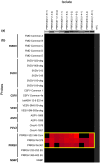A multiplex reverse transcription PCR and automated electronic microarray assay for detection and differentiation of seven viruses affecting swine
- PMID: 29194985
- PMCID: PMC7169841
- DOI: 10.1111/tbed.12749
A multiplex reverse transcription PCR and automated electronic microarray assay for detection and differentiation of seven viruses affecting swine
Abstract
Microarray technology can be useful for pathogen detection as it allows simultaneous interrogation of the presence or absence of a large number of genetic signatures. However, most microarray assays are labour-intensive and time-consuming to perform. This study describes the development and initial evaluation of a multiplex reverse transcription (RT)-PCR and novel accompanying automated electronic microarray assay for simultaneous detection and differentiation of seven important viruses that affect swine (foot-and-mouth disease virus [FMDV], swine vesicular disease virus [SVDV], vesicular exanthema of swine virus [VESV], African swine fever virus [ASFV], classical swine fever virus [CSFV], porcine respiratory and reproductive syndrome virus [PRRSV] and porcine circovirus type 2 [PCV2]). The novel electronic microarray assay utilizes a single, user-friendly instrument that integrates and automates capture probe printing, hybridization, washing and reporting on a disposable electronic microarray cartridge with 400 features. This assay accurately detected and identified a total of 68 isolates of the seven targeted virus species including 23 samples of FMDV, representing all seven serotypes, and 10 CSFV strains, representing all three genotypes. The assay successfully detected viruses in clinical samples from the field, experimentally infected animals (as early as 1 day post-infection (dpi) for FMDV and SVDV, 4 dpi for ASFV, 5 dpi for CSFV), as well as in biological material that were spiked with target viruses. The limit of detection was 10 copies/μl for ASFV, PCV2 and PRRSV, 100 copies/μl for SVDV, CSFV, VESV and 1,000 copies/μl for FMDV. The electronic microarray component had reduced analytical sensitivity for several of the target viruses when compared with the multiplex RT-PCR. The integration of capture probe printing allows custom onsite array printing as needed, while electrophoretically driven hybridization generates results faster than conventional microarrays that rely on passive hybridization. With further refinement, this novel, rapid, highly automated microarray technology has potential applications in multipathogen surveillance of livestock diseases.
Keywords: African swine fever; classical swine fever; foot-and-mouth disease; microarray; multiplex PCR; swine vesicular disease.
© 2017 Her Majesty the Queen in Right of Canada • Transboundary and Emerging Diseases.
Figures



Similar articles
-
Multiplex RT-PCR detection and microarray typing of vesicular disease viruses.J Virol Methods. 2011 Aug;175(2):236-45. doi: 10.1016/j.jviromet.2011.05.023. Epub 2011 May 19. J Virol Methods. 2011. PMID: 21620898
-
Development of a one-step multiplex qRT-PCR assay for the detection of African swine fever virus, classical swine fever virus and atypical porcine pestivirus.BMC Vet Res. 2022 Jan 18;18(1):43. doi: 10.1186/s12917-022-03144-4. BMC Vet Res. 2022. PMID: 35042532 Free PMC article.
-
Development of a multiplex qRT-PCR assay for detection of African swine fever virus, classical swine fever virus and porcine reproductive and respiratory syndrome virus.J Vet Sci. 2021 Nov;22(6):e87. doi: 10.4142/jvs.2021.22.e87. J Vet Sci. 2021. PMID: 34854269 Free PMC article.
-
Detection of economically important viruses in boar semen by quantitative RealTime PCR technology.J Virol Methods. 2004 Sep 15;120(2):151-60. doi: 10.1016/j.jviromet.2004.04.014. J Virol Methods. 2004. PMID: 15288957 Free PMC article.
-
Porcine Dendritic Cells and Viruses: An Update.Viruses. 2019 May 16;11(5):445. doi: 10.3390/v11050445. Viruses. 2019. PMID: 31100880 Free PMC article. Review.
Cited by
-
African Swine Fever Diagnosis in Africa: Challenges and Opportunities.Pathogens. 2024 Apr 2;13(4):296. doi: 10.3390/pathogens13040296. Pathogens. 2024. PMID: 38668251 Free PMC article. Review.
-
Fusion Expression and Immune Effect of PCV2 Cap Protein Tandem Multiantigen Epitopes with CD154/GM-CSF.Vet Sci. 2021 Sep 29;8(10):211. doi: 10.3390/vetsci8100211. Vet Sci. 2021. PMID: 34679041 Free PMC article.
-
Recent Advances in the Diagnosis of Classical Swine Fever and Future Perspectives.Pathogens. 2020 Aug 15;9(8):658. doi: 10.3390/pathogens9080658. Pathogens. 2020. PMID: 32824178 Free PMC article. Review.
-
Advances in the Diagnosis of Foot-and-Mouth Disease.Front Vet Sci. 2020 Aug 21;7:477. doi: 10.3389/fvets.2020.00477. eCollection 2020. Front Vet Sci. 2020. PMID: 32974392 Free PMC article. Review.
-
Development of Diagnostic Tests Provides Technical Support for the Control of African Swine Fever.Vaccines (Basel). 2021 Apr 2;9(4):343. doi: 10.3390/vaccines9040343. Vaccines (Basel). 2021. PMID: 33918128 Free PMC article. Review.
References
-
- Ambagala, A. , Fisher, M. , Goolia, M. , Nfon, C. , Furukawa‐Stoffer, T. , Ortega Polo, R. , & Lung, O. (2016). Field‐deployable reverse transcription‐insulated isothermal PCR (RT‐iiPCR) assay for rapid and sensitive detection of foot‐and‐mouth disease virus. Transboundary and Emerging Diseases, 64, 1610–1623. - PMC - PubMed
-
- Banér, J. , Gyarmati, P. , Yacoub, A. , Hakhverdyan, M. , Stenberg, J. , Ericsson, O. , … Belák, S. (2007). Microarray‐based molecular detection of foot‐and‐mouth disease, vesicular stomatitis and swine vesicular disease viruses, using padlock probes. Journal of Virological Methods, 143, 200–206. - PubMed
-
- Christianson, W. T. , & Joo, H. (1994). Porcine reproductive and respiratory syndrome: A review. Swine Health and Production, 2, 10–28.
MeSH terms
Grants and funding
LinkOut - more resources
Full Text Sources
Other Literature Sources
Medical

